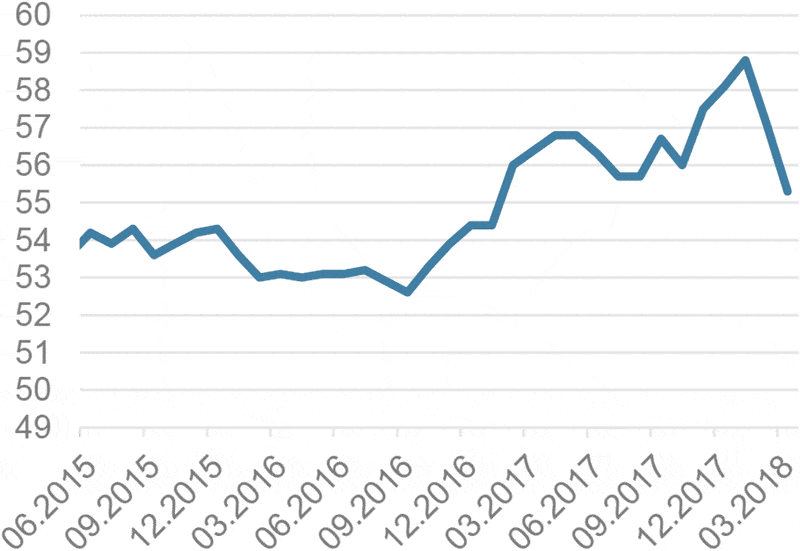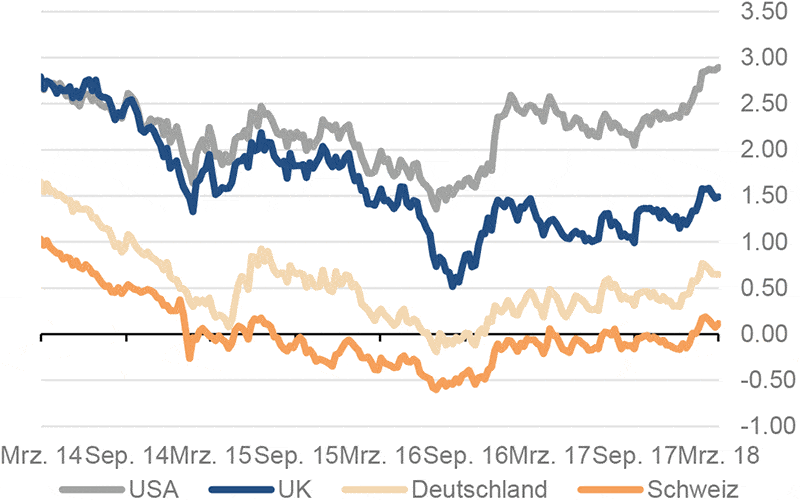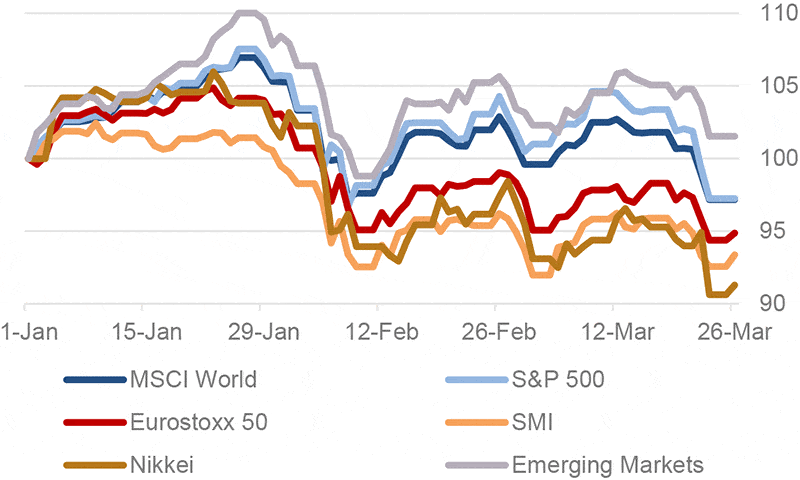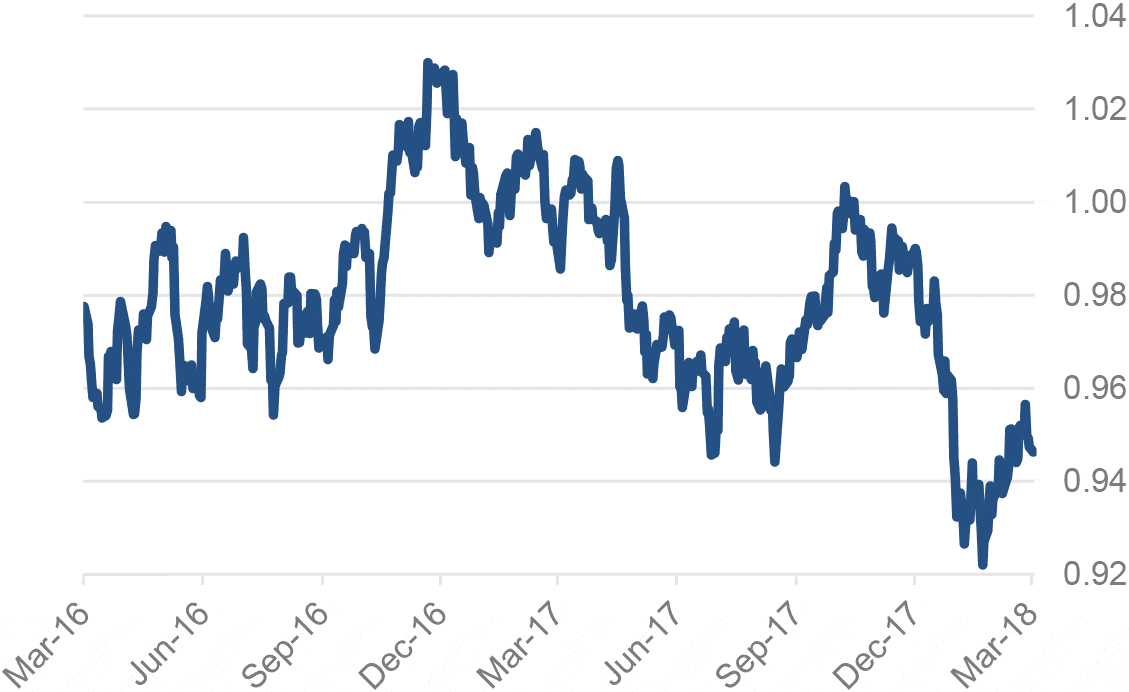Executive Summary
- We expect the global economy to grow by around 3.5% in 2018. The upswing will lose momentum slightly, especially in the euro zone.
- Switzerland is expected to grow at around 2.0% in 2018.
- The Trump administration is currently discussing the imposition of protective tariffs.
- U.S. fiscal policy is procyclical and ruins the U.S. national budget in the medium term. The twin deficit problem becomes an issue.
- We expect the ECB to raise interest rates for the first time in H2 2019. The ECB took another verbal step toward scaling back stimulus: It no longer mentioned the so-called "easing bias".
- Global equity markets, led by the U.S., have returned to "businessasusual" surprisingly quickly.
- In recent weeks, there has been a significant calming in government bond yields.
Our macroeconomic assessment
Business cycle
- We have the following economic growth forecasts for 2018 and, in brackets, for 2019.
- With the exception of the USA, a further acceleration in growth can be ruled out.
- On the contrary, the next few months will see a slight, non-dramatic weakening of the very high sentiment indicators and then, with a delay, a slight weakening of real growth.
- The Swiss economy is benefiting from the strong economic tightening in Europe. Real growth in Switzerland is expected to reach 2.0%.
- The emerging markets will grow strongly in 2018. In China, we expect growth to decline slightly.
Purchasing managers' index for the euro zone

Source: Bloomberg
Monetary policy
- The US economy is currently growing very fast. The Trump administration's pro-cyclical fiscal policy could trigger a more restrictive monetary policy by the FED, unless a "major trade war" were to impair growth. We expect 4 interest rate hikes.
- Higher wage growth should slowly push the core inflation rate toward the target inflation rate 2%.
- The BOE is expected to decide on a rate hike in Q2.
- The ECB is likely to end its bond-buying programs toward the end of 2018 and turn the interest rate screw for the first time in H2 2019. This will also enable the SNB to slowly exit the policy of negative interest rates.
- The BOJ will continue to stimulate most aggressively of all central banks.
Our investment policy conclusions
Bonds
- In recent weeks, there has been a significant calming of government bond yields. The upward trend in both the U.S. and Europe has been broken. One major reason for this was the latest U.S. labor market data, which showed that the upturn in wages is continuing at a rather moderate pace after all. Secondly, the calm and transparent communication by the FED allayed certain fears of an uncontrolled rise in interest rates.
- Within the euro zone, the decline in yields was almost more accentuated and, in our view, also makes sense, as there is no reason whatsoever for the ECB to deviate from its accommodative course. Mario Draghibetonounced more than once at the last ECB press conference that inflation is far from where one would like it to be. We remain underweight high-yield bonds and prefer emerging market bonds.
Yield on 10-year government bonds, since 2014

Source: Bloomberg
Equities
- Soon the reporting season of companies for the first quarter of 2018 will begin. In the US, estimates for the increase in profits are at a very high level (+17%). The risk of a negative surprise is certainly higher than already. In Europe, the situation is somewhat different, with estimated earnings much lower. However, the reporting on the last quarter has also shown here that the market punishes mercilessly in case of "non-fulfillment".
- However, all these optimistic statements only apply if President Trump's announced protectionist measures do not materialize to the full extent. A sharp escalation of the trade conflict would render the forecasts for global economic growth as a wastepaper. Due to the uncertainties that have recently arisen, we have scaled back our allocation slightly.
Equitiy markets, perfomance year do date

Source: Bloomberg
Forex
- The USA is pursuing a procyclical fiscal policy, and President Trump's fiscal stimulus has come at the worst possible time. There is a threat of economic overheating in the USA in 2018, and the first signs are already visible on the labor market in particular. The US unemployment rate remains at a low 4.1%. One result of this constellation is that the euro is under appreciation pressure due to the current account surpluses and the greenback is thus weakening. This is because the twin deficits and also the increasing debt are casting the greenback in a poor light.
- EUR/CHF has defined a new trading band with prices hovering very closely around 1.15. This was not changed by the crash in equity prices at the end of January.
USD/CHF 2 years

Source: Bloomberg
Disclaimer: Information and opinions contained in this document are gathered and derived from sources which we believe to be reliable. However, we can offer no undertaking, representation or guarantee, either expressly or implicitly, as to the reliability, completeness or correctness of these sources and the information provided. All information is provided without any guarantees and without any explicit or tacit warranties. Information and opinions contained in this document are for information purposes only and shall not be construed as an offer, recommendation or solicitation to acquire or dispose of any investment instrument or to engage in any other transaction. Interested investors are strongly advised to consult with their Investment Adviser prior to taking any investment decision on the basis of this document in order to discuss and take into account their investment goals, financial situation, individual needs and constraints, risk profile and other information. We accept no liability for the accuracy, correctness and completeness of the information and opinions provided. To the extent permitted by law, we exclude all liability for direct, indirect or consequential damages, including loss of profit, arising from the published information.
Disclaimer: Produced by Investment Center Aquila Ltd.
Information and opinions contained in this document are gathered and derived from sources which we believe to be reliable. However, we can offer no under-taking, representation or guarantee, either expressly or implicitly, as to the reliability, completeness or correctness of these sources and the information pro-vided. All information is provided without any guarantees and without any explicit or tacit warranties. Information and opinions contained in this document are for information purposes only and shall not be construed as an offer, recommendation or solicitation to acquire or dispose of any investment instrument or to engage in any other trans
action. Interested investors are strongly advised to consult with their Investment Adviser prior to taking any investment decision on the basis of this document in order to discuss and take into account their investment goals, financial situation, individual needs and constraints, risk profile and other information. We accept no liability for the accuracy, correctness and completeness of the information and opinions provided. To the extent permitted by law, we exclude all liability for direct, indirect or consequential damages, including loss of profit, arising from the published information.





